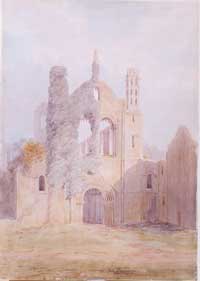 |
 |
 |
 |
 |
 |
 |
|
The foundation of Kirkstall: from Barnoldswick to Kirkstall (2/3) The move to Kirkstall
The site at Barnoldswick was from the outset beset with problems; Henry actually held this land of Hugh Bigod, earl of Norfolk, for the annual sum of five marks and a hawk, a rent which he had for several years neglected to pay. Strictly speaking the land was not his to give away. Furthermore, the location was later to prove unsuitable for monastic life since the community was exposed to plunder and violence from the civil wars and suffered adverse weather conditions - the Foundation History of Kirkstall explains that a plague of rains ruined their crops. It is interesting to note that according to modern research, the winter of 1148-9 was particularly severe and the period 1151-2 marked by several extremely wet spells.(4) After six years of hardship, Abbot Alexander contemplated a change of site. One day, whilst travelling on abbey business, he passed through the present site of Kirkstall, which was at that time a shady, wooded spot in the valley of the R. Aire, inhabited by several hermits.(5) The abbot thought this a suitable site for the community and approached Henry de Lacy to discuss the congregation’s possible relocation. The land in question actually belonged to William Peitevin, who held it of Henry de Lacy, but the Foundation History of the house stresses that Henry was the driving force behind William’s grant to the monks of this land, along with water and woodland nearby. Links between Kirkstall and the Peitevin family were sustained until the fourteenth century, and interestingly, Kirkstall’s coat of arms is based on William’s rather than the de Lacy’s.(6) On 19 May 1152 the monks moved to their new site at Kirkstall, at this time a wilderness: A place covered with woods and unproductive of crops, a place destitute of good things save timber and stone and a pleasant valley with the water of a river which flowed down its centre. (7)
Several of the hermits joined the community, the others yielded their right to live there in return for a sum of money from Henry de Lacy. The monks’ former site at Barnoldswick became a grange and the community renamed itself ‘Kirkstall’. This new site was in many suitable for establishing community life. Stone for quarrying could be transported along the River Aire; a water supply was channelled from springs and streams that ran above the abbey as well as from the millpond;(8) Hawksnorth Wood bounded the abbey to the west and afforded shelter, as well as fuel, pasturage and building resources. Having led the community to their new site Abbot Alexander embarked upon a building programme, and during his thirty-five year abbacy the essential building-work was completed. |

